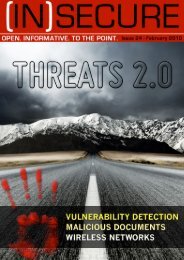You also want an ePaper? Increase the reach of your titles
YUMPU automatically turns print PDFs into web optimized ePapers that Google loves.
Have you ever left the light, radio or TV on when you left home? The idea is<br />
usually that would-be burglars would see the lights or hear the noise, assume<br />
someone was there and move on to less dangerous targets. Over the ages, we<br />
humans have become very well versed at feeding our foes false stimuli, using<br />
trickery and deceit as a defensive technique. In the information age, little has<br />
changed, other than the medium. This remains a highly effective tool for<br />
adding to the security of an organization.<br />
Using honeypot techniques in the corporate IT<br />
world has some challenges, but done properly,<br />
the capabilities are simply amazing. Honeypots<br />
have been around in the IT world for<br />
quite some time.<br />
The Honeynet Project, probably the most significant<br />
work in the field, was founded in 1999.<br />
While their work is primarily focused on high<br />
interaction, academic study of attacker techniques<br />
by offering target systems and network<br />
environments up for exploitation, their implementations<br />
likely require more than most corporate<br />
organizations can manage in time, effort,<br />
forensic analysis and capability.<br />
However, by simplifying honeypot technologies<br />
away from a systemic approach to emu-<br />
lation of specific services we can begin to<br />
pare down the requirements to a more manageable<br />
level.<br />
Further, by refining the idea of what data the<br />
honeypot should gather from the deeply academic<br />
to the more focused “get what a corporate<br />
IT person needs” we can easily extend<br />
the idea of a “low interaction” honeypot into<br />
the corporate IT environment.<br />
The underlying principle is easy to understand.<br />
If something is fake, then there is essentially<br />
no reason why anyone should interact<br />
with it. If we emulate a fake web server, for<br />
example, no legitimate users of the network<br />
should ever use it, since it holds no real data<br />
or significance for them.<br />
www.insecuremag.com 38





